Tom Rock’s philosophy is to let the horses dictate their trimming or shoeing schedules — unless circumstances demand otherwise.
Tom Rock, like other farriers, is a strong advocate of pursuing hobbies and interests outside of the equine world. He’s a knowledgeable farrier and a solid horseman, but says if you don’t “get away” from it once in a while, you’ll burn out. The Wadsworth, Ill., farrier has a few pursuits outside of farriery to relax — chief among these being golf.
If Rock wanted to play golf at the end of this “Shoeing For A Living” day, he would be smart to catch a flight to a destination far from the southwestern shores of Lake Michigan. With a subzero wind chill through most of the January day, golf and most outdoor activities are off the table for any sensible person.
But no matter how cold or hot the temperature is, horses always will need proper hoof care, so farriers endure. And so will Rock, as the chill is more of an annoyance than an obstruction — he’s lived in northern Illinois most of his life and has been a farrier in the area for about 10 years. All of the work today is set in nice performance horse barns, so there is some shelter from the arctic air.
When asked what his best winter shoeing tip is, Rock says, “Go somewhere warm.” Although this is his wry sense of humor coming forward, the joke is similar to Rock’s approach to hoof care: the answer is simple and direct. This thinking was demonstrated by the hoof care of the horses he works with on this particular day.
8:15 a.m. We leave Rock’s home for the first stop, which is nearly an hour away in Wayne, Ill. The drive is a common hassle faced by farriers who cover metropolitan areas: the quickest driving route usually isn’t the direct one because of traffic congestion. Rock will navigate through the Interstate system wrapped around Chicago to get to the southwest suburb from his northern-suburb home.
The drive gives Rock time to talk about his history in shoeing. Rock found farriery as a career in his late 30s. After losing his job as a retail buyer of outdoor goods about 10 years ago, his farrier, Rob Fryer, planted the hoof-care bug. He rode along with his horseshoer for about 3 months, seeing if he would enjoy the work. Following that trial, he went to the Midwest Horseshoeing School in Macomb, Ill.
Upon graduation, he spent years apprenticing with Fryer and other established farriers in his area, like Ross Hutton of Wonder Lake, Ill. He credits this time as important to his development and interest in various equine disciplines as it gave him access to high-end show horses. Rock finds this, along with a commitment to education, has a lot to do with being able to work at quality English riding barns so early in his career.
His service area stretches from the southern and western Chicago suburbs to southeast Wisconsin. The area spans nearly 150 miles. Rock doesn’t charge his clients a barn fee or mileage, as he builds that cost into his trimming and shoeing prices. And like other farriers, he plans out his days in advance for maximum efficiency in his drive.
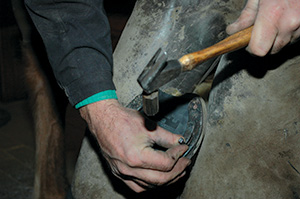
With his horses, Rock prefers as few nails as possible and uses clips to aid secure placement.
“I definitely don’t want to make a trip to only do one horse,” he says. Rock also covers for farriers Scott Lampert of Elmo Lake, Minn., and Marcus Lybarger of Venice, Fla., both of whom have accounts in his area. So between their trips to the area, he can fill in with their accounts.
Networking and comparing work with high-caliber farriers like Lampert and Lybarger and overall education are important to Rock and a popular theme throughout the day. He regularly attends meetings like the International Hoof-Care Summit and the Northeast Association of Equine Practitioners annual symposium, and is a member of the American Association of Professional Farriers.
Some farriers may balk at the overall attendance costs of traveling out of state or country for a learning experience, but Rock says the cost is minimal to what he gets in return. However, education isn’t limited to lectures, wet labs or competitions. If applied correctly, mistakes can provide powerful lessons.
“You won’t learn unless you make mistakes,” says Rock. “The key is to admit them and learn from the mistakes. It’s a common problem in the horse industry, people will often complain about someone else’s mistake to everyone other than the person who made the mistake. How can that person learn from it? No one benefits from this and the horses end up suffering.”
9:19 a.m. Rock parks his truck and trailer outside a barn door at Koerner Farm, a hunter/jumper stable where he has 11 horses.
First is a gelding named Copper. Rock picks up the front left foot, looking to see if anything has changed. He notes no serious concerns with the shoe wear, other than he’s not going to have resets this time. He’s been working with this horse for several cycles and has the feet in a stage of maintenance. That’s not to say the feet were in bad shape before. And if they were, Rock wouldn’t necessarily blame the previous farrier.
“When it is a new horse to me, I may see something I don’t like,” says Rock. “Unless it is something really detrimental, I’m not going to knock somebody’s work. In many cases, I don’t think you can fairly judge someone else’s work until you’re back for a third time. What I see today is only today and may be very different 6 weeks from now. You don’t know what the growth is unless you go through the cycle.”
He pulls the shoes, takes another look at the feet and trims the fronts and hinds. Deep into winter, there isn’t much to trim.
9:42 a.m. Rock shapes each shoe at his Future 3 anvil to symmetrically fit the foot. He takes the left front shoe in to hot fit while the front right heats up in the Whisper Mamma forge. Like many farriers, he hot shapes every shoe and also will hot fit each one if the horse is willing. To Rock it doesn’t make sense to add to wear and tear through more effort when heating the shoe can avoid that.
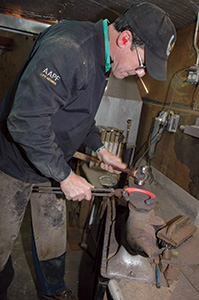
Safety is important for Rock, who wears protective lenses and customized ear plugs whenever he is at the anvil, grinder or forge.
Rock hot fits the Kerckhaert DFs on the bottom of the foot, but doesn’t burn the quarter clips deep into the hoof wall, feeling he gets the good fit without compromising the wall. That’s why he prefers these shoes, as the clips are built more to the outside of the shoe. He uses DFs and SX-8s for the hunters and jumpers he works with. He keeps a healthy supply of shoes and pads on his rig, having enough supply where he isn’t caught off guard by his maintenance or therapeutic cases.
10:01 a.m. After safing the shoes and taking in the heels a bit at the grinder, he will add Borium to each heel for traction. The owner prefers Borium for the winter months. Rock would prefer studs, but the Borium will deliver adequate traction and not be detrimental to the horse.
Rock will move up to a Castle Plastics’ 2-degree pad on both fronts. He made this decision based on what he read in shoe wear and that he wants to adjust the support. He adds Vettec’s Equi-Pak Soft to fill the back of the pad at the heels. With the low temperature in the barn, the set-up takes a few extra minutes, allowing Rock to finish the hinds. Rock prefers Soft as he finds it maintains the density he wants with his horses.
10:38 a.m. Rock is able to get a reset with the next horse, a mare named Cinder. Along with the SX-8 reset, the horse will keep Castle Plastics Rim Sno Pads with several weeks of winter left.
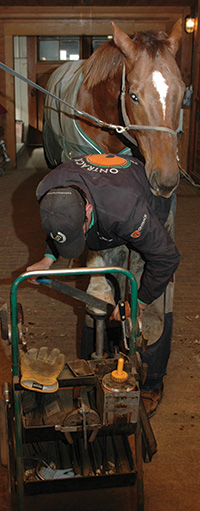
Winter definitely means “less is more,” when trimming, but Rock doesn’t necessarily become aggressive in his footcare approach come spring or summer.
Before Rock cleans, shapes or safes the shoes at the grinder, he takes some safety measures. Safety is an important subject for Rock. Although not a hoof-care injury, he is missing the tip and nail of his right thumb. About 2 years ago while practicing roping, he helped another rider who was struggling. A roping dummy tumbled, spooking the other rider’s horse. When the horse bolted, the rope Rock was helping to untangle jerked and the injury occurred. It was a reminder of how things quickly can go from good to bad. Although he wasn’t a careless farrier in regard to safety, Rock earned a tough reminder. The injury hasn’t hampered his ability to work with horses.
He now is adamant about protecting his body, for example, by wearing eye and ear protection while working at the anvil and grinder. Although safety gear is not that uncommon among farriers, Rock advises against cutting corners. He always had difficultly keeping in the foam earplugs that can be found at any drug store. One of his clients is an audiologist and gave him custom-fit earplugs, a combination of comfort and safety for the farrier.
11:11 a.m. When talking about shaping his shoes, Rock recalls a picture of a shoe that New Mexico farrier Craig Trnka made for a cadaver foot.
“He removed the sole and coffin bone, and the bone fit inside,” he says. “That’s what I try to do. I don’t like straight lines, especially on a foot.
“Granted there are times when it is necessary to put a lot of work into a shoe, but I’ve pulled off a lot of shoes in my time where someone has used a lot of effort to make perfect.”
When placing the shoe prior to nailing, he looks more for a 50/50 balance from the bridge.
“I want half of the shoe behind the bridge,” he says. “The front of my shoe is probably longer, but where it breaks over is the front half. In some cases, like the theory of setting the shoe back, shouldn’t it be more in the mechanics of the shoe? It’s simple if you’re going to roll or rocker the toe.”
While he nails the shoe on the front left, Rock says he prefers Mustad MX55 nails for this shoe and horse. He’s had good luck with these nails in terms of fit and keeping shoes on. He also gets by with the fewest nails he can, aided by the clips. In the case of his hunter/jumpers, that’s four nails.
Rock gouges his clinches for aesthetic reasons, but hasn’t found any way of clinching that is better than others.
11:43 a.m. The next horses all get trims, being retired fox hunters who may see some work in the fall. Again this is winter, so with the limited foot growth, Rock is careful just to trim and rasp the foot for maintenance. He applies Hoof Heal to most feet he works with for the shine.
His swiftness shouldn’t be confused with carelessness. You could sum up Rock’s approach with the adage “less is more.” He believes more in applying solid fundamentals with minimal changes for upkeep. Trimming to the horse’s needs in winter doesn’t mean he changes his philosophy in spring or summer. Yes, the foot will experience more growth, but Rock will address that according to the foot’s needs without changing his approach.
When he trims a foot, he follows steps common with other farriers, like examining for the medial-lateral balance by looking down the back of the leg. He subscribes to the theory of universal sole thickness to guide his trim. Rock lets the landmarks on the bottom of the foot guide him, starting with Duckett’s Bridge.
“It’s simple: Take off what you need to and leave the rest, otherwise you’ll make them sore,” he says.
Environment is huge. For Rock, it doesn’t always register with some farriers when considering the effects of trimming or shoeing.
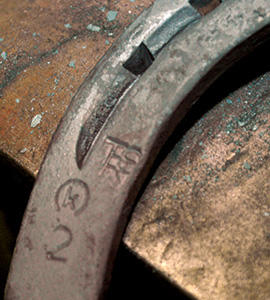
Sure, he could easily stamp the heels in his shoes with a dot or two like most farriers, but Rock prefers to use the logo for his farrier business, TSR Farrier Service. Centaur Forge in Burlington, Wis., made the stamp for Rock.
“There’s no one way to do things,” he says. “I won’t shoe this horse the same way I’d shoe her elsewhere. All she has to do is move to another location and things might be different.”
12:23 p.m. When Rock finishes loading his shoeing box and tools back into the trailer, there is no invoice delivered to, or check collected from Koerner Farm.
Chasing clients for money isn’t a problem for Rock these days. Back in November 2012 he changed to a system modeled off of one he saw Coshocton, Ohio, farrier Dave Farley discuss in a clinic. Since changing to this system, Rock has had only one barn drop him — the one that owed him a significant amount of money and sparked this change.
The program begins with a letter explaining the new payment structure, the reasoning behind it and other rules for billing, including penalties for invoicing. A second sheet contains fields for the owner to fill in regarding their horse and credit card information.
Rock records the information pertaining to the client’s service that day and then his fiancée, Penny Nelson, processes the payment via the Square mobile payment device. Square takes 2.75% of the payment as a processing fee per transaction.
To integrate this program into a farrier practice, Rock says to send the letter out at least 1 month before you change. For him, it coincided with a new year. This allowed clients to become aware of it prior to their next shoeing appointment. Be respectful and appreciative of their business on both documents. Also include that their information is confidential and secure.
“A couple of people joked about it, but for the most part the results have been great,” says Rock. “People use credit cards for buying everything in their daily lives. Why should the farrier have to wait for payments, when other professions like plumbers expect payment at the time service is completed?”
Working in another industry impacted Rock’s approach to business. In the retail field, customer service is everything. This training gave him an understanding of communication and the psychology of what people are actually saying. Rock recommends any young farrier should try to work in a similar service-related field so they can learn these traits.
One thing he doesn’t enjoy about the business is fielding phone calls for things like booking appointments. But because a task is annoying doesn’t mean it should be ignored. Rock suggests delegating business-oriented tasks that take away from your enjoyment of running a farrier practice. Call services and accountants aren’t free though, but Nelson (who is a hunter/jumper trainer) has incorporated this duty into her daily business.
“It was taking away from my work,” Rock says. “When working on horses, you don’t want to check the phone all day. Plus, I don’t want to have to take calls or read texts while driving and try to book the next appointment at that time. Getting an immediate response is something that clients expect.”
Rock finds poor business practices hurt many farriers and cause their businesses to fail.
“Some entrepreneurs start a business, but don’t know how to run a business,” says Rock. “This is true of many horseshoers. You may enjoy horses and the actual farrier work, but there is more to making a business successful.”
A book that Rock recommends to other farriers for business education is The E-Myth Revisited: Why Most Small Businesses Fail And What To Do About It. Written by Michael Gerber, it examines entrepreneurship and various levels, illustrating how small businesses fail because of poor planning and leadership.
Industry ethics also are important to Rock. Consider that delinquent-paying barn that forced Rock to reconsider how he is paid. Despite owing him money, the barn hired another farrier. He is disappointed that the newer farrier didn’t check with him, the former farrier, about his experience there. He feels farriers should communicate more to protect one another from bad situations.
“I call other guys and I get calls from other guys,” he says. “It is a professional courtesy, but it also is for my own protection, too. I don’t want to work at a place where I’ll have trouble collecting money.”
2:12 p.m. The next stop is Field and Fences Equestrian Center, a dressage and hunter/jumper facility located a few miles from Rock’s home. It was a long lunch, but Rock was happy to oblige because showing up earlier at this barn would mean the horses would be turned out.
Rock likes working with performance horse owners because he finds they typically have a higher degree of horsemanship than most backyard owners. But that knowledge can sometimes come with unrealistic expectations.
“Whether I as the farrier like it or not, the owner wants that horse performing this weekend. A backyard owner might have a 4-H event a few times in the summer — much lower stakes.
“Backyard horses are a companion animal and owners like the idea of looking out the window and seeing the horse. It’s a job for performance horse people. Sure they love the animals and care or them, but in a way they are commodities. They are trying to sell something.”
2:33 p.m. After pulling his shoeing box to the aisle, Rock first will work with Ranger, a jumper gelding. He returns the horse to the stall almost as quickly as he removed the gelding. The horse’s left hind was bandaged. At the time, Rock had no information on what the issue was, and there were no instructions from the vet or owner. Later he would find out that the horse suffers from lymphangitis.
Not willing to work on Ranger, Rock goes down his list to the next horses — new shoes for a show jumper and trims for two school ponies.
2:47 p.m. Rock is trimming the jumper’s hind right foot with a hoof knife from Ringel Custom Knives. As a collector he appreciates knives and has practiced making a knife from a rasp. He learned about knives from his days in outdoor equipment sales.
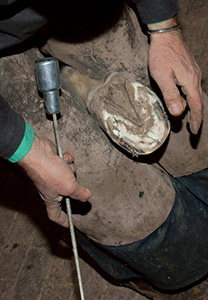
Like many other farriers, Rock’s analyzes the foot before and while working with the horse by examining the medial-lateral balance.
“The tricky part with knives is the right balance,” he finds. “You want hard steel, but not so hard that you can’t sharpen it.”
He carries an assortment of straight blade, loop and abscess probes. He prefers Ringel’s knives because they don’t need sharpening as frequently with other hoof knives he’s used.
Finished with his trim, Rock rasps the toe with the foot atop a Hoofjack, a product he says he couldn’t do without. Admittedly, he has never used another hoof stand, but that’s because he hasn’t had to. After 10 years, it has been kicked, thrown and banged around. He finally replaced the rubber knob back in July 2012. He hasn’t changed the strap in the cradle yet.
Rock’s philosophy for trimming and shoeing cycles serves as a reminder of what the farrier’s job is. Some barns want regimented scheduling. Rock is happy to oblige the owner in that case. With other accounts, he has to manage the schedule. But at other barns, like the previous one, he builds in flexibility, especially in winter.
When working with other horses a week or 2 prior to the next visit, Rock may look at the feet before he leaves. If any of the horses don’t need their feet handled in the coming week, he will postpone the work if the extra time likely won’t cause problems. Postponement with a horse could result in losing a cycle or two over a year, but Rock says the finances shouldn’t drive the decision.
“I remember reading about a farrier who dropped a client because the client wouldn’t get on a ‘regular’ schedule,” he says. “OK, so what’s a regular schedule? Is it for you or the horse? Is the horse better served by being trimmed on that exact schedule? I think in some cases a horse is better served by not having its feet done. Who are you working for?”
Obviously, having other accounts in the barn is crucial so the farrier can keep close tabs on those horses without adding extra time to visit a barn where he or she isn’t working. Plus, fluctuations in the cycles that add more weeks between the visits at the barn will affect this. Don’t assume because a horse could go a couple of weeks longer, that it necessarily can do that in the next cycle.
Yes, you have to do some horses to accommodate yourself. Also, it isn’t possible with every case based on the individual needs of the horses and the job they perform. You need to be established to where you are adequately charge for the work you deliver.
4:41 p.m. After the horses at the equestrian center, there is one last trim before calling it a day. The horse is the only one Rock works with at Kelly Stables, a dressage barn. Normally, he wouldn’t take on a single horse at a location, but this horse has been on his books for 6 years and, beyond sentiment, it is about a mile away from his home.
“This horse has been with me for a long time and this is its third barn,” says Rock. “It wouldn’t make much sense to work with it if it wasn’t here. I schedule it for Mondays so I can come here on my way home.
Rock only takes in his apron, a hoof knife, nippers, rasp and Hoofjack. The horse stands well, as did all of the other horses today and like the others, received its “maintenance” trim.
After 15 minutes of trimming and talking, the groom takes the horse back in its stall, Rock returns his tools to the trailer and hangs up his apron for the day.
After starting the GMC’s engine, he turns to me and jokingly asks, “Well, that was a boring day, wasn’t it?” Maybe it is dull if you are looking for a day filled with complexities of lame horses, treated with unique shoeing solutions. Today was about sustaining quality hoof care for sound horses.
These sort of days can present their own type of challenges if one strays from fundamentals or deals with tough clients. But if the name of the game is keeping horses sound through footcare based on their present and individual needs, farriers should prefer “boring” days like today when “Shoeing For A Living.”
With his horses, Rock prefers as few nails as possible and uses clips to aid secure placement.

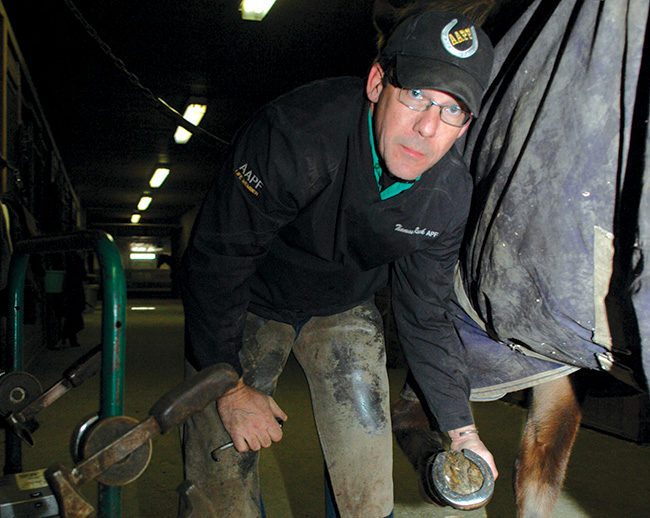







Post a comment
Report Abusive Comment